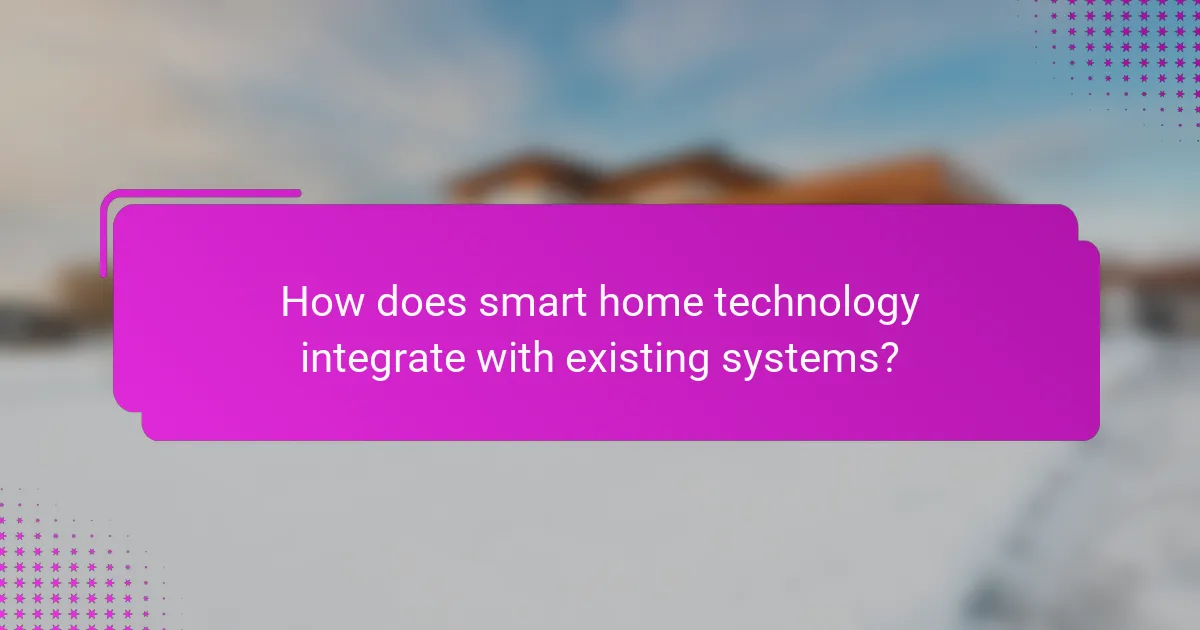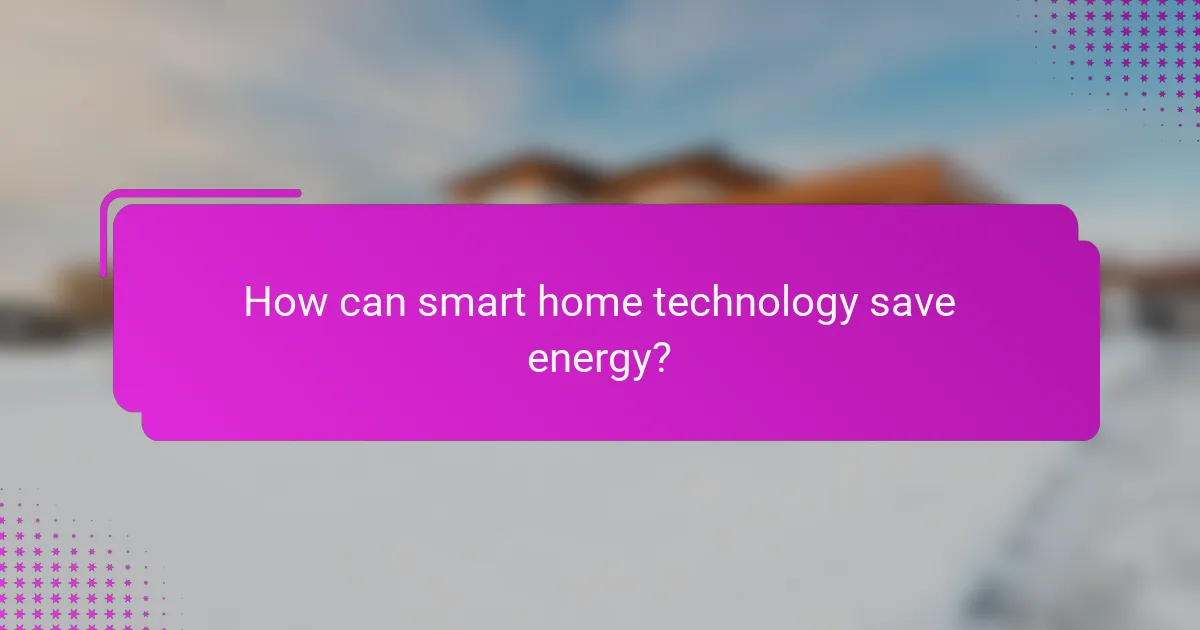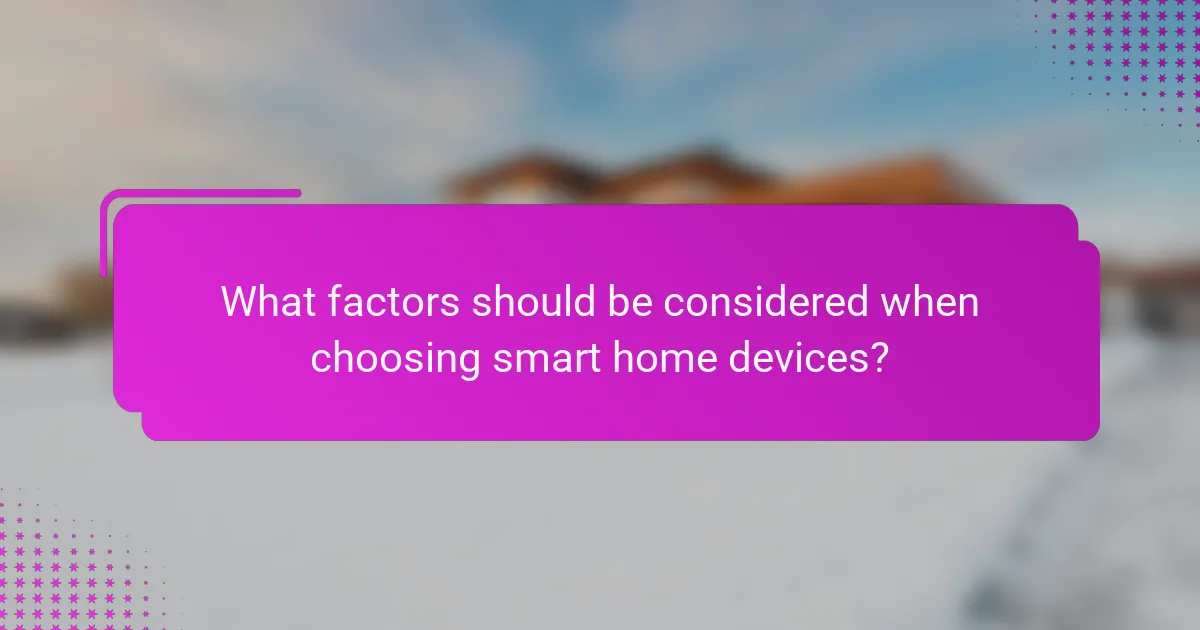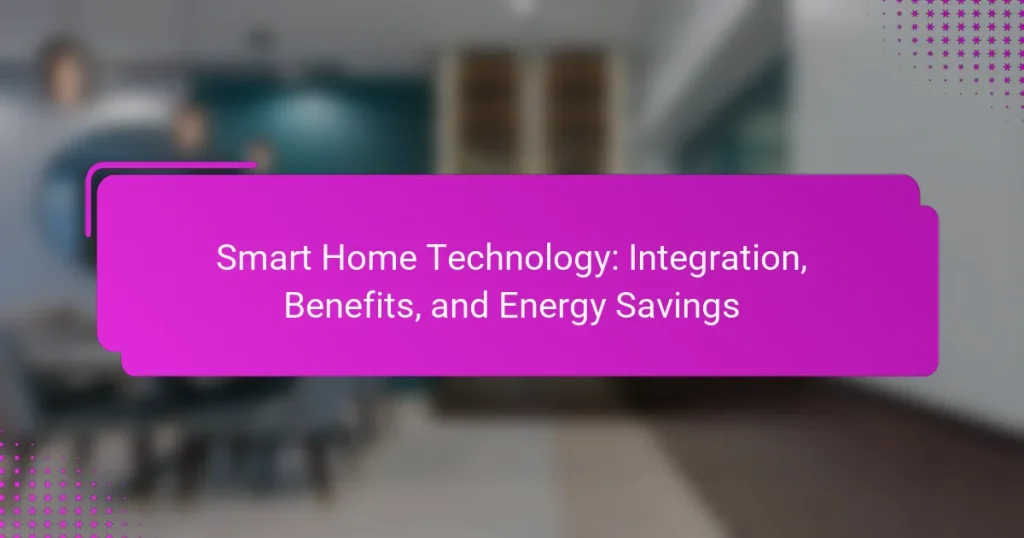Smart home technology revolutionizes the way we manage our living spaces by integrating various devices and systems through common communication protocols. This seamless connectivity not only enhances convenience and security but also promotes energy efficiency, allowing homeowners to optimize their energy consumption and reduce utility costs. By embracing smart technology, individuals can create a more streamlined and sustainable home environment.

How does smart home technology integrate with existing systems?
Smart home technology integrates with existing systems by utilizing common communication protocols and networks. This allows various devices to work together seamlessly, enhancing convenience and efficiency in home management.
Integration with Wi-Fi networks
Most smart home devices connect through Wi-Fi networks, enabling remote access and control via smartphones or tablets. Ensure your home Wi-Fi has sufficient bandwidth to support multiple devices simultaneously, as congestion can lead to slow response times.
Consider using a dual-band router to manage both 2.4 GHz and 5 GHz connections, which can help optimize performance for different devices. If you have a larger home, Wi-Fi extenders may be necessary to maintain strong signals throughout.
Compatibility with smart assistants
Smart home technology often works with popular smart assistants like Amazon Alexa, Google Assistant, and Apple HomeKit. This compatibility allows users to control devices using voice commands, making operation more intuitive.
When selecting devices, check for compatibility with your preferred smart assistant to ensure seamless integration. Some devices may require additional setup or specific apps to function correctly with these assistants.
Use of IoT protocols
The Internet of Things (IoT) protocols, such as Zigbee, Z-Wave, and Thread, facilitate communication between smart devices. These protocols enable devices to connect and interact without relying solely on Wi-Fi, which can improve reliability and reduce network congestion.
When choosing devices, consider those that support multiple IoT protocols for greater flexibility and future-proofing. This can also enhance interoperability among devices from different manufacturers.
Integration with security systems
Smart home technology can integrate with existing security systems, allowing for enhanced monitoring and control. Devices such as smart locks, cameras, and motion sensors can be managed through a single app, providing a comprehensive security solution.
Ensure that your security system supports integration with smart home devices, as this can vary by brand. Regularly update the firmware of your security devices to maintain compatibility and security.
Interoperability with smart appliances
Smart appliances, like refrigerators, ovens, and thermostats, can communicate with each other and with your smart home hub. This interoperability allows for automated routines, such as adjusting the thermostat when you leave home or receiving alerts about food spoilage.
When purchasing smart appliances, look for those that are compatible with your existing smart home ecosystem. This can help you avoid compatibility issues and maximize the benefits of automation in your home.

What are the benefits of smart home technology?
Smart home technology offers numerous benefits, including enhanced convenience, improved security, and increased energy efficiency. By integrating various devices and systems, homeowners can enjoy a more streamlined and efficient living environment.
Increased convenience and automation
Smart home technology significantly enhances convenience by automating everyday tasks. For instance, smart lighting systems can be programmed to turn on or off at specific times, while smart thermostats can adjust temperatures based on your schedule. This level of automation not only saves time but also reduces the need for manual adjustments.
Additionally, voice-activated assistants allow users to control various devices hands-free, making it easier to manage home systems while multitasking. This seamless integration of technology simplifies daily routines and enhances overall lifestyle quality.
Enhanced security features
Smart home technology improves security through advanced monitoring and alert systems. Devices such as smart cameras, doorbell cameras, and motion sensors provide real-time surveillance and notifications, allowing homeowners to keep an eye on their property from anywhere. These features can deter potential intruders and provide peace of mind.
Moreover, smart locks enable keyless entry and can be programmed to grant access to specific individuals at designated times. This level of control enhances security while offering convenience for homeowners and their guests.
Improved energy efficiency
Smart home technology contributes to energy efficiency by optimizing the use of resources. Smart thermostats can learn your habits and adjust heating and cooling accordingly, potentially reducing energy bills by 10-15%. Similarly, smart lighting systems can automatically turn off lights in unoccupied rooms, minimizing unnecessary energy consumption.
Homeowners can also monitor their energy usage through smart plugs and energy management systems, allowing them to identify and address high-consumption devices. This proactive approach to energy management leads to both cost savings and a reduced environmental footprint.
Remote monitoring and control
Remote monitoring and control are key features of smart home technology, enabling homeowners to manage their systems from anywhere via smartphone apps. This capability allows for real-time adjustments to heating, cooling, and security settings, providing flexibility and peace of mind.
For example, if you forget to turn off the lights or adjust the thermostat before leaving home, you can easily do so from your mobile device. This level of control not only enhances convenience but also helps in maintaining energy efficiency and security while away from home.

How can smart home technology save energy?
Smart home technology can significantly reduce energy consumption by optimizing how and when energy is used in a household. Through automation and intelligent management of devices, homeowners can lower their utility bills while minimizing their environmental impact.
Smart thermostats like Nest
Smart thermostats, such as Nest, learn your heating and cooling preferences and adjust the temperature accordingly. They can automatically lower the temperature when you’re away or asleep, potentially saving 10-15% on heating and cooling costs annually.
To maximize savings, ensure your thermostat is connected to a reliable Wi-Fi network and take advantage of features like scheduling and remote access. Regularly check for software updates to benefit from the latest energy-saving algorithms.
Energy-efficient lighting solutions
Switching to energy-efficient lighting, such as LED bulbs, can drastically reduce electricity usage. LEDs use up to 80% less energy than traditional incandescent bulbs and last significantly longer, often exceeding 25,000 hours.
Consider installing smart lighting systems that allow you to control brightness and color remotely or set schedules. This can further enhance energy savings, especially in rooms that are frequently unoccupied.
Automated power management
Automated power management systems help monitor and control the energy consumption of various devices in your home. These systems can identify energy hogs and allow you to schedule usage during off-peak hours when rates may be lower.
Implementing smart plugs or power strips can provide insights into energy use and enable you to turn off devices remotely. Look for systems that integrate with other smart home devices for seamless operation and enhanced efficiency.

What factors should be considered when choosing smart home devices?
When selecting smart home devices, consider compatibility with existing systems, brand reliability, and the balance between cost and features. These factors will help ensure a seamless integration and maximize the benefits of your smart home setup.
Device compatibility
Device compatibility is crucial for creating a cohesive smart home environment. Ensure that the devices you choose can communicate with each other and with your central hub, whether it’s a smartphone app or a dedicated control panel. Look for products that support common standards like Zigbee, Z-Wave, or Wi-Fi.
Check if the devices are compatible with your existing smart home ecosystem, such as Amazon Alexa, Google Assistant, or Apple HomeKit. This will allow for easier control and automation across different devices.
Brand reliability
Brand reliability plays a significant role in the longevity and performance of smart home devices. Research brands known for quality and customer support, as this can save you time and money in the long run. Look for reviews and ratings from other users to gauge the reliability of the devices you’re considering.
Established brands often provide better software updates and security features, which are essential for protecting your home network. Avoid lesser-known brands that may lack a proven track record in the smart home market.
Cost vs. features
When evaluating smart home devices, it’s important to weigh the cost against the features offered. Set a budget and prioritize the features that matter most to you, such as energy monitoring, remote access, or automation capabilities. This will help you avoid overspending on unnecessary features.
Consider the long-term savings that energy-efficient devices can provide, which may justify a higher upfront cost. Look for devices with good energy ratings or those that can integrate with energy management systems to maximize savings.


